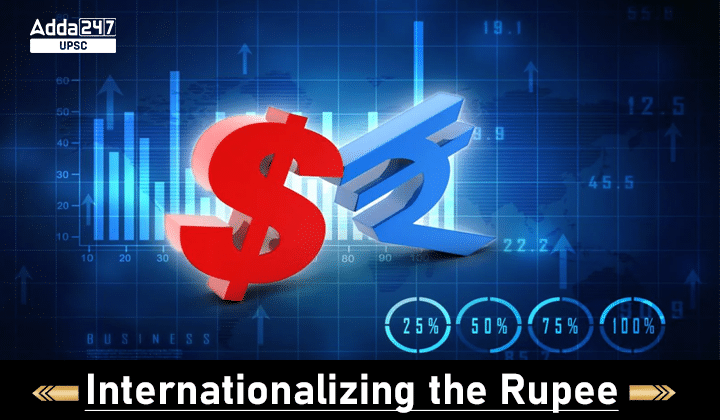Table of Contents
What is the Internationalisation of Rupee?
The Internationalisation of Rupee refers to the process of increasing the usage of the Indian rupee in cross-border transactions. It involves promoting the rupee for international trade, both for imports and exports, and gradually expanding its use in other types of transactions, such as capital account transactions.
This process is crucial for the nation’s economic progress and requires measures to open up currency settlement, strengthen swap and forex markets, and eventually achieve full convertibility of the rupee on the capital account.
Currently, major global reserve currencies include the US dollar, Euro, Japanese yen, and pound sterling. While efforts have been made by China to internationalize its currency, the renminbi, it has achieved limited success thus far.
Relevance for UPSC Exam
Questions related to currency, foreign exchange, and international trade may feature in the Economy section of the Prelims. Understanding the concept of Internationalisation of Rupee is important for answering such questions accurately.
Internationalisation of Rupee-Context
The Indian government’s recent announcement of a long-term roadmap for further Internationalisation of Rupee holds significant potential. While the Indian rupee was widely accepted in several Gulf countries in the 1950s, subsequent developments, such as the introduction of sovereign currencies and demonetization, have impacted confidence in the rupee. However, the Internationalisation of Rupee is crucial, and careful consideration must be given to address concerns expressed by India’s neighboring countries.
Internationalisation of Rupee-Limited International Demand
Currently, the rupee has limited international demand, with its daily average share in the global foreign exchange market hovering around 1.6%. This is in contrast to India’s share of global goods trade, which stands at approximately 2%.
Despite some measures taken to promote the Internationalisation of Rupee, such as enabling external commercial borrowings in rupees and facilitating trade in rupees with certain countries, transactions in the rupee remain limited. Additionally, India still predominantly purchases oil from Russia in dollars, and efforts to settle trade in rupees with Russia have faced challenges.
Internationalisation of Rupee-Learnings from China’s
China’s Internationalisation of the Renminbi (RMB) offers valuable lessons. China adopted a phased approach, initially allowing the use of the RMB outside China for current account transactions and select investment transactions. Over time, China signed currency swap agreements with various countries and established offshore clearing banks and trading zones. These measures gradually internationalised the RMB and increased its share of international reserves.
Internationalisation of the Rupee Reforms
To Internationalise of Rupee, several reforms can be pursued. Firstly, the rupee should be made more freely convertible, with the goal of full convertibility by 2060. This would enhance liquidity and attract foreign investors.
Additionally, a deeper and more liquid rupee bond market should be developed to provide investment options in rupees for foreign investors and trade partners. Encouraging Indian exporters and importers to invoice transactions in rupees would optimize trade settlement formalities.
Advantages of Internationalisation of the Rupee
- Mitigates Currency Risk: The Internationalisation of Rupee reduces currency risk for Indian businesses engaged in cross-border transactions. By using the rupee for international trade, businesses can minimize the impact of currency volatility, leading to cost savings and improved business growth opportunities.
- Reduces Foreign Exchange Reserves: As the use of the rupee in international transactions increases, there is a reduced need for holding large foreign exchange reserves. This decreases the cost associated with maintaining reserves and makes the Indian economy less vulnerable to external shocks.
- Improved Bargaining Power: With a significant presence of the rupee in global transactions, Indian businesses gain increased bargaining power. This enhances the overall economic strength of India and elevates its stature and respect on the global stage.
- Enhanced Global Presence: The Internationalisation of Rupee allows Indian businesses to expand their global reach and establish a stronger presence in international markets. This opens up opportunities for increased trade, investment, and collaboration, contributing to India’s economic growth and development.
- Facilitates Economic Growth: A more widely accepted rupee in international transactions fosters economic growth by attracting foreign investment and promoting exports. It creates a favorable environment for businesses to thrive, ultimately benefiting the Indian economy as a whole.
Currency swap agreements, like the one with Sri Lanka, can enable trade and investment transactions in rupees without relying heavily on reserve currencies like the dollar.
Tax incentives for foreign businesses using the rupee in their Indian operations would also be beneficial. Currency management stability and a predictable exchange rate regime are essential, as excessive demonetization or devaluation could impact confidence. The rupee could also be promoted as an official currency in international organizations to enhance its profile.
Internationalisation of Rupee
Recommendations
Implementing the Tarapore Committee’s recommendations, including reducing fiscal deficits, controlling inflation, and addressing banking non-performing assets, would contribute to the rupee’s stability and acceptance on the global stage.
Internationalisation of Rupee
Conclusion
The government’s roadmap for the Internationalisation of Rupee offers numerous advantages, including facilitating Indian businesses’ global operations, enhancing liquidity, and improving financial stability. Careful currency management policies, predictable exchange rate regimes, and measures to address the concerns of neighboring countries are necessary for successful implementation. The Internationalisation of Rupee is a delicate balance between convertibility and exchange rate stability, and its realization can significantly benefit Indian citizens, enterprises, and the government’s financial objectives.
UPSC Practice Question
“Discuss the potential benefits and challenges of the Internationalisation of Rupee for India’s economy and its role in strengthening India’s global presence. Examine the strategies and reforms required to facilitate the Internationalisation process and analyze the impact on areas such as trade, investment, currency stability, and financial sector reforms.”
| Follow US | |
| UPSC Govt. Jobs UPSC Current Affairs UPSC Judiciary PCS Download Adda 247 App here to get the latest updates |



 TSPSC Group 1 Question Paper 2024, Downl...
TSPSC Group 1 Question Paper 2024, Downl...
 TSPSC Group 1 Answer key 2024 Out, Downl...
TSPSC Group 1 Answer key 2024 Out, Downl...
 UPSC Prelims 2024 Question Paper, Downlo...
UPSC Prelims 2024 Question Paper, Downlo...
